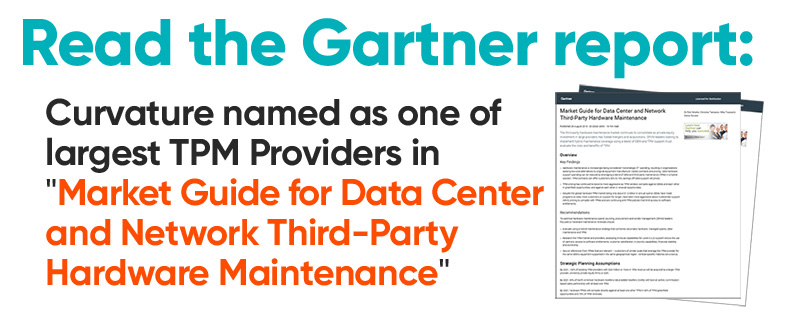Ask any data center owner or operator what keeps them awake at night and you’re likely to hear how managing competing priorities is like a high-wire act. No letup or letdown is acceptable when it comes to striking the right balance between innovations that drive businesses forward and essential tasks that keep networks and data centers running in top form.
Gartner has a term called “bimodal IT,” or the practice of managing two separate but coherent styles of work: One focused on predictability; the other on exploration. We believe both play essential roles in digital transformation.1
On the predictable side, hardware maintenance most often dominates the “nonstrategic IT” spending bucket. Sure it’s essential, but should you pay top dollar when significant savings off manufacturer support prices can be achieved? Since first reporting on the market for Third Party Maintenance (TPM), industry thought leaders have followed the steady growth in the market for independent support.
A hybrid maintenance strategy that uses OEM-authorized and OEM-independent maintenance is becoming more common in the hardware support business. According to Gartner’s most recent Market Guide for Data Center and Network Third-Party Hardware Maintenance, “TPM contracts can offer customers 50% to 70% savings off OEM support net prices.2″
These savings certainly are in line with what Curvature customers realize by embracing hybrid maintenance solutions. For years, we have helped thousands of our customers worldwide not only rein in their OpEx spending to a more reasonable level but also provide them with substantial CapEx relief.
Implementing a hybrid strategy accomplishes this by determining which hardware is best left on manufacturer support (typically anything that still requires software updates) while transferring gear that has exceeded traditional support windows to TPM. A savvy hybrid strategy also typically includes other budget-friendly options, including use of secondary market hardware and managed spares.
Besides the obvious and substantial cost savings of moving post-warranty gear to TPM, Gartner asserts other potential benefits of TPM including: 3
“Extending the life of IT assets: Almost all of the installed base supported by TPMs is postwarranty or after end of service life (EOSL). This can provide organizations with flexibility to delay upgrade projects, especially when moving workloads to the cloud.”
“Flexibility in contract terms: Some enterprises consider the flexibility and customized support from TPMs an advantage over OEM contracts. For example, OEMs will typically not entertain a contract of less than a full year. A TPM, on the other hand, is typically willing to provide a customer a short-term contract of, for example, nine months (or less).”
“Leverage against an OEM quote: Not all OEMs are prepared to lower support costs if you threaten to move to a TPM or have a TPM quote in hand. Some will not budge on price, while others will lower their price.”
Furthermore, engaging with leading TPM providers like Curvature also opens the door to additional IT capabilities. For example, Curvature offers a broad range of professional services, including data center and cloud migrations, IT asset disposition, upgraded wireless coverage and more. Managing a multi-vendor data center not only requires masterful administration, it demands an objective perspective and proven expertise across all the leading manufacturer platforms.
While Third Party Maintenance is not new to the IT landscape, the last four years have seen it become a much more accepted part of a well-rounded data center strategy. According to Gartner, “Develop a broad, optimized hybrid maintenance strategy that combines secondary hardware, OEM maintenance, OEM-independent TPM and managed spares.”4
A hybrid support strategy delivers the best of both worlds, extending the life of still-useful IT assets while taking back control of when upgrades take place. The result, pairing TPM’s substantial cost savings with manufacturer support where necessary, achieves “no-brainer” status.
Get Complimentary Access to Gartner’s Market Guide for Data Center and Network Third-Party Hardware Maintenance by filling out the form below:
1.https://www.gartner.com/en/information-technology/glossary/bimodal
2.According to Gartner, “Hardware maintenance is increasingly being considered “nonstrategic IT” spending, resulting in organizations seeking low-cost alternatives to original equipment manufacturer (OEM) contracts and pricing. OEM hardware support spending can be reduced by leveraging a blend of OEM and third-party maintenance (TPM) in a hybrid solution. TPM contracts can offer customers 50% to 70% savings off OEM support net prices.” Gartner, Market Guide for Data Center and Network Third-Party Hardware Maintenance; Rob Schafer, Christine Tenneson, Mike Toussaint, Daniel Bowers; 29 August 2019.
Gartner does not endorse any vendor, product or service depicted in its research publications, and does not advise technology users to select only those vendors with the highest ratings or other designation. Gartner research publications consist of the opinions of Gartner’s research organization and should not be construed as statements of fact. Gartner disclaims all warranties, express or implied, with respect to this research, including any warranties of merchantability or fitness for a particular purpose.
3. Gartner, Market Guide for Data Center and Network Third-Party Hardware Maintenance; Rob Schafer, Christine Tenneson, Mike Toussaint, Daniel Bowers; 29 August 2019
4. Gartner, Market Guide for Data Center and Network Third-Party Hardware Maintenance; Rob Schafer, Christine Tenneson, Mike Toussaint, Daniel Bowers; 29 August 2019



